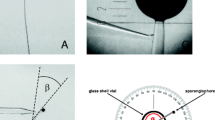Summary
Cycloheximide (CH) was applied selectively either to the shoot apex or by infiltration to the leaves of the long-day plant Hyoscyamus niger in order to investigate whether this inhibitor has an effect on the synthesis of a floral stimulus in the leaves. Treatment of the shoot apex with CH caused inhibition of the photoperiodic induction. In contrast, when CH was applied to leaves, initiation of flowering was observed under short-day conditions. The drug yielded optimum initiating effects at concentrations of 10-5-3·10-5 M, inducing flowering of almost 60% of the plants. Daily infiltration over a period of up to 4 days decreased the rate of flower initiation. The effect of CH was shown to be additive to a photoperiodic induction, even to a sub-threshold induction, but not to 2-thiouracil mediated induction. In no case did the presence of additional untreated leaves on the plants suppress CH-mediated flower induction. Treatment of the leaves with chloramphenicol (10-6-2-10-4 M) or puromycin (5·10-6-2·10-4 M) caused no initiating response. The results are interpreted to mean that the presence of CH in the leaves may lead to the synthesis of a floral stimulus also under short-day conditions. This finding is similar to that reported previously in the case of the inductive effect of 2-thiouracil.
Similar content being viewed by others
Abbreviations
- 2-TU:
-
2-Thiouracil
- CH:
-
Cycloheximid
- LT:
-
Langtag
- DL:
-
Dauerlicht
Literatur
Collins, W. T., Salisbury, F. B., Ross, C. W.: Growth regulators and flowering. III. Antimetabolites. Planta (Berl.) 60, 131–144 (1963).
Denffer, D. v.: Blühhormon oder Blühhemmung? Neue Gesichtspunkte zur Physiologie der Blütenbildung. Naturwissenschaften 37, 297–301, 317–321 (1950).
Eichhoff, E., Rau, W.: Auslösung der Blütenbildung bei der Langtagpflanze Hyoscyamus niger im Kurztag durch 2-Thiouracil. Planta (Berl.) 87, 290–303 (1969).
Ellis, H. J., MacDonald, I. R.: Specificity of cycloheximide in higher plant systems. Plant Physiol. 46, 227–232 (1970).
Evans, L. T.: Inflorescence initiation in Lolium temulentum L. VI. Effects of some inhibitors of nucleic acid, protein, and steroid biosynthesis. Aust. J. biol. Sci. 17, 24–35 (1964).
Evans, L. T.: Flower induction and the florigen concept. Ann. Rev. Plant Physiol. 22, 365–394 (1971).
Evans, L. T., Knox, R. B., Rijven, A. H. C.: The nature of localisation of early events in the shoot apex of Lolium temulentum during floral induction. In: Cellular and molecular aspects of floral induction, p. 192–206, Bernier, G., ed. London: Longman Group Ltd. 1970.
Gibby, D. D., Salisbury, F. B.: Participation of long-day inhibition in flowering of Xanthium strumarium L. Plant Physiol. 47, 784–789 (1971).
Goren, R., Monselise, S. B.: Promotion of flower formation and fruit set in Citrus by antimetabolites of nucleid-acid and protein synthesis. Planta (Berl.) 88, 364–368 (1969).
Lang, A.: Physiology of flower initiation. In: Handbuch der Pflanzenphysiologie, Bd. XV/1, S. 1380–1536, Ruhland, W., Hrsg. Berlin-Heidelberg-New York: Springer 1965.
Lang, A., Melchers, G.: Über den hemmenden Einfluß der Blätter in der photoperiodischen Reaktion der Pflanze. Naturwissenschaften 29, 82–83 (1941).
Melchers, G.: Die Wirkung von Genen, tiefen Temperaturen und blühenden Pfropfpartnern auf die Blühreife von Hyoscyamus niger. Biol. Zbl. 57, 568 (1937).
Rau, W.: Über die Wirkung von einmaligen 2,4-Dinitrophenolgaben auf die Atmung von Blattgeweben. Planta (Berl.) 58, 136–143 (1962).
Ross, C.: Antimetabolite studies and the possible importance of leaf protein synthesis during induction of flowering in the cocklebur. In: Cellular and molecular aspects of floral induction, p. 139–151, Bernier, G., ed. London: Longman Group Ltd. 1970.
Schwabe, W. W.: Flower inhibition in Kalanchoe blossfeldiana. Bioassay of an endogenous long-day inhibitor and inhibition by ± abscisic acid and xanthoxin. Planta (Berl.) 103, 18–23 (1972).
Wellensiek, S. J.: The rate of floral deblocking in Silene armeria L. Z. Pflanzenphysiol. 61, 462–471 (1970).
Yoshida, K. K., Umemura, K., Yoshinaga, K., Oota, Y.: Specific RNA from photoperiodically induced cotyledons of Pharbitis nil. Plant Cell Physiol. 8, 97–108 (1967).
Author information
Authors and Affiliations
Additional information
Herrn Prof. Dr. L. Brauner in Verehrung und Dankbarkeit zum 75. Geburtstag gewidmet.
Rights and permissions
About this article
Cite this article
Klautke, S., Rau, W. Auslösung der Blütenbildung durch Cycloheximid im Kurztag bei der Langtagpflanze Hyoscyamus niger . Planta 112, 25–34 (1973). https://doi.org/10.1007/BF00386028
Received:
Issue Date:
DOI: https://doi.org/10.1007/BF00386028




